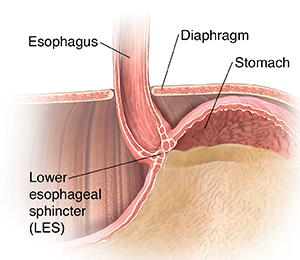Understanding the Stretta Procedure for GERD
Understanding the Stretta Procedure for GERD
There is a one-way valve between the esophagus and stomach. This is called the lower esophageal sphincter (LES). The LES normally opens when you swallow. It lets food enter your stomach, then closes. But when you have GERD (gastroesophageal reflux disease), the LES opens too often. Fluids and stomach acid can flow from the stomach back into the esophagus. This can cause difficult symptoms. Stomach acid can also hurt the esophagus and lead to long-term problems.
The Stretta procedure is a nonsurgical treatment for GERD. It uses heat waves to strengthen the muscles around the LES, so it opens less often. This helps prevent GERD.
Why the Stretta procedure is done
The Stretta procedure may be advised if you have GERD and:
Don’t get enough relief from GERD medicines
Can’t take GERD medicines
Don’t want to take GERD medicines long-term
Want to try a nonsurgical procedure for GERD
How the Stretta procedure is done
The Stretta procedure is most often done on an outpatient basis. That means that you go home the same day. During the procedure:
You are given medicine (anesthesia) to help you relax and to prevent pain. You may also sleep lightly during the procedure.
The doctor puts a thin, lighted tube (endoscope) into your mouth. He or she passes the tube down your throat and into the esophagus to your stomach. The tube sends live images to a video screen.
The doctor puts wires through the tube. These are moved to the LES. These wires carry controlled levels of radiofrequency energy to the LES. This heats up the tissues of the LES and makes them tighten.
When the procedure is done, the wires and tube are removed.
After the procedure, it takes several weeks or longer before GERD symptoms begin to improve.
Risks of the Stretta procedure
These include:
Bleeding
Infection
Irritation of the esophagus
Hole (perforation) in the esophagus
Trouble swallowing
Chest pain
Problems related to the anesthesia
Updated:
March 21, 2017
Sources:
Franciosa M, et al. Stretta Radiofrequency Treatment for GERD: A Safe and Effective Modality. Gastroenterology Research and Practice. 2013:1-8., Muthusamy VR, et al. The role of endoscopy in the management of GERD. Gastroenterology Endoscopy. 2015;81(5):1305–10., The role of endoscopy in the management of GERD. Gastrointestinal Endoscopy. 2015;81(6):1305-10., Triadafilopoulos G. Stretta: A valuable endoscopic treatment modality for gastroesophageal reflux disease. World of Gastroenterology. 2014 June 28;20(24):7730-8., Yeh RW, et al. Endoscopic Antireflux Therapy: The Stretta Procedure. Thorac Surg Clin. 2005:395-403.
Reviewed By:
Images Reviewed by Staywell medical art team.,Lehrer, Jennifer K, MD,Ziegler, Olivia, MS, PA
